Book contents
- Frontmatter
- Contents
- Acknowledgements
- Preface
- Foreword
- Author affiliations
- Abbreviations
- 1 The paradoxical nature of nature
- 2 Paradoxical effects of sensory loss
- 3 Paradoxical functional facilitation and recovery in neurological and psychiatric conditions
- 4 Paradoxes in neurorehabilitation
- 5 The paradoxical self
- 6 Paradoxical psychological functioning in early child development
- 7 Cognitive ageing: a positive perspective
- 8 Paradoxes of learning and memory
- 9 The paradox of human expertise: why experts get it wrong
- 10 Paradoxes in Parkinson's disease and other movement disorders
- 11 Paradoxical phenomena in epilepsy
- 12 Paradoxical creativity and adjustment in neurological conditions
- 13 Paradoxical functional facilitation with noninvasive brain stimulation
- 14 Unexpected benefits of allergies and cigarette smoking: two examples of paradox in neuroepidemiology
- 15 The paradox of autism: why does disability sometimes give rise to talent?
- 16 Paradoxes in creativity and psychiatric conditions
- 17 The paradox of psychosurgery to treat mental disorders
- 18 The paradox of electroconvulsive therapy
- 19 Paradoxes of comparative cognition
- 20 Paradoxical phenomena in brain plasticity
- 21 Immature neurons in the adult brain. Breaking all the rules
- 22 The paradoxical hippocampus: when forgetting helps learning
- 23 Paradoxical effects of drugs on cognitive function: the neuropsychopharmacology of the dopamine and other neurotransmitter systems
- 24 The paradoxical brain – so what?
- Index
- References
4 - Paradoxes in neurorehabilitation
Published online by Cambridge University Press: 05 December 2011
- Frontmatter
- Contents
- Acknowledgements
- Preface
- Foreword
- Author affiliations
- Abbreviations
- 1 The paradoxical nature of nature
- 2 Paradoxical effects of sensory loss
- 3 Paradoxical functional facilitation and recovery in neurological and psychiatric conditions
- 4 Paradoxes in neurorehabilitation
- 5 The paradoxical self
- 6 Paradoxical psychological functioning in early child development
- 7 Cognitive ageing: a positive perspective
- 8 Paradoxes of learning and memory
- 9 The paradox of human expertise: why experts get it wrong
- 10 Paradoxes in Parkinson's disease and other movement disorders
- 11 Paradoxical phenomena in epilepsy
- 12 Paradoxical creativity and adjustment in neurological conditions
- 13 Paradoxical functional facilitation with noninvasive brain stimulation
- 14 Unexpected benefits of allergies and cigarette smoking: two examples of paradox in neuroepidemiology
- 15 The paradox of autism: why does disability sometimes give rise to talent?
- 16 Paradoxes in creativity and psychiatric conditions
- 17 The paradox of psychosurgery to treat mental disorders
- 18 The paradox of electroconvulsive therapy
- 19 Paradoxes of comparative cognition
- 20 Paradoxical phenomena in brain plasticity
- 21 Immature neurons in the adult brain. Breaking all the rules
- 22 The paradoxical hippocampus: when forgetting helps learning
- 23 Paradoxical effects of drugs on cognitive function: the neuropsychopharmacology of the dopamine and other neurotransmitter systems
- 24 The paradoxical brain – so what?
- Index
- References
Summary
Summary
We consider how a number of interventions that would normally interfere with function have paradoxically improved symptoms in patients with neurological conditions. These include distorting reality, constraining patients' ability to perform everyday tasks, impeding vision, temporarily disabling healthy brain tissue, and distracting patients from the task at hand. We argue that the effects of these diverse interventions can be understood within a general framework of brain function that emphasizes competition for limited capacity resources. We discuss how this competition can be biased to produce rehabilitation benefits.
Introduction
Neurorehabilitation refers to any intervention that aims to reduce impairment caused by brain injury, disease or developmental abnormality. It also refers to techniques that help compensate for such impairments or that facilitate adjustment (Wilson,1996). Much that is effective in rehabilitation is far from paradoxical. People relearn and improve through practice, encouragement and the setting of incremental, achievable goals (e.g. Wilson et al., 2009). Where full restoration of a function is not possible, as is often the case, compensatory aids such as diaries and communication devices can facilitate independence (Kime, 2006; Kapur and Wilson, 2009). Patients and families can gain comfort, perspective and realistic hope from discussion with professionals and other patients.
In line with the focus of this book, here we concentrate on particular interventions that under normal circumstances may be considered deleterious or contrary to perceived wisdom, but which have been shown to reduce or offset impairment in people with brain injuries.
- Type
- Chapter
- Information
- The Paradoxical Brain , pp. 74 - 93Publisher: Cambridge University PressPrint publication year: 2011
References
- 1
- Cited by



